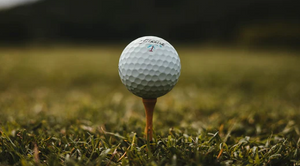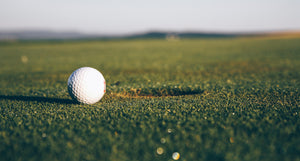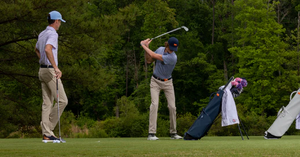5 Golf Exercises to Improve Your Game
Golf may not seem like a game requiring substantial physical exertion, especially compared to sports like tennis or football, but a surprising amount of physical fitness is required.
Like all sports, golf requires honing certain muscle groups specific to this game.
Many golfers experience limitations to their game due to swing faults. Some of these problems with technique can be corrected using tailored exercises that strengthen key muscle groups.
Targeted exercises help develop the most important muscles used in a golf swing, such as the gluteal muscles. Weak gluteal muscles contribute to multiple swing faults, including slide, early extension, sway, loss of posture, S-posture, and reverse spine angle.
The good news is that you don’t need a gym membership to hone the core golf muscles. Read on to discover the essential at-home golf exercises to improve technique and swing speed while protecting against injuries.
1. Side Step-ups
This exercise works on a specific muscle called the gluteus medius.
A strong gluteus medius provides lateral stabilization for the hips, creating a solid base to support the energy of the upper body as the arms swing through and provide force to the clubhead.
Start with a low step-up, like one step on your stairs or a small step outside. The depth of step can gradually increase to develop the muscles.
As you do this exercise, a good tip is to raise your toes to make sure the leg is lifting all your weight on the step.
Do 15 repetitions on each leg and then repeat two or three times in one session for maximum results.
This exercise also benefits the hamstrings and quadriceps in the pushing leg.
2. Core Rotations
Core rotations work the abdominal muscles. Use a 10lb dumbbell or, for something more advanced, a 20lb medicine ball.
Lie on your back and rotate your waist to the opposite side for one repetition and then repeat between 25-30 times. That is one complete set. Two to three sets will develop good results.
You can start with your feet on the floor, but try to keep your feet off the floor as you advance.
3. Lunges with Rotation
These exercises specifically strengthen the lower body and create separation between the two halves of the body. The intention is to provide a stable base and a flexible and powerful upper body.
This exercise uses a basic movement, the lunge, common in many programs, particularly in fencing. The rotations add the specific requirement that all golfers need: separation.
Start in a standing position and then lunge forward on the leading leg with a large step. The back knee should touch the floor slightly. The lead leg should lower and lift the body weight.
Next, reach across your body with one arm. Straighten the other arm and point it towards the ceiling. This opening of the body creates mobility in the thoracic spine and develops better separation and rotation during the swing.
Complete fifteen of these on each side and a total of two to three sets for best results.
4. Cat Camels
Cat camels strengthen critical muscles around the lower back, hips, and abdomen to create mobility in the lower spine. Cat camels increase rotational range.
Begin on all fours. Lower your head and gently push your spine upwards towards the ceiling, like a cat arching its back. Do this slowly three or four times without overstretching or forcing the spine.
Next, lift your head into an extended stretch. Gently lower the back, a reverse of what you have just done. This fluid movement is the camel stretch. Repeat these three or four times.
Finish the exercise with a repeat of the cat stretches.
The camel stretch activates the hamstrings and the abdominal muscles to lift the pelvis. The cat stretch gives the thoracic spine mobility—the thoracic spine runs from the base of the neck down to the abdomen—and allows rotation of the upper body.
Cat camels can eliminate the S and C-postures that plague many golfers. Perform a set of twenty repetitions and then repeat a complete set two or three times.
5. Sword Draws
Get into your golf stance and take a dumbbell and gently externally rotate your shoulder blade. The movement contracts the posterior muscles and strengthens the stabilizers of the shoulder joint, a key focus of good golf technique.
The rotations should be slow to protect against injury and achieve the best results. Concentrate on maintaining a good posture throughout this exercise.
Finish the exercise by setting the weight at the highest point just as you would with your club during the swing movement.
This exercise promotes good posture during the swing without any forced positioning or tension. It will make the swing more efficient by developing solid shoulders and a powerful core.
Perform fifteen repetitions on each side for one complete set and then repeat two or three times.
Frequently Asked Questions
What Muscles Increase Golf Swing Speed?
The muscles of the lower back, when toned and firm, increase swing speed as well as control the power and force that comes with that extra speed.
Most golfers have experienced soreness or even pain and injury in the lower back at some point in their lives. This discomfort indicates the critical role these muscles play in swing speed and how developing them can protect against injury.
Quads, hamstrings, and glutes—some of the muscles in your legs—will help keep a solid base, aid swing speed, and control the speed. Swing speed is no good if the power is not controlled.
Any weaknesses in the legs will usually show up as a loss of posture on a fast swing.
Hand and forearm strength, especially the latter, are often a key focus for swing speed. However, the lower back and legs are probably more significant in generating dynamic motion.
At the same time, muscular forearms are essential for generating speed with a short swing, such as playing from bunkers.
What Muscles Should I Build for Golf?
The gluteal muscles are essential to good swing technique. The gluteal muscles are a group of three muscles that comprise the buttocks. They are the gluteus maximus, the gluteus medius and the gluteus minimus.
These muscles provide mobility and power for the lower body. In particular, the hips and strong gluteals also offer stabilization.
The core is used throughout the golf swing to control power and direction. A strong core involves the abdominal muscles and supports proper posture and good rotation.
The abdominal muscles consist of four muscles: the rectus abdominis, internal and external obliques, and the transverse abdominis.
If you are serious about your game, you can work with a sports physiotherapist or personal trainer and craft a personalized training program.
Most golfers only seek sports physiotherapy after an injury, but these programs can proactively assist with strengthening the key muscles used in golf. This proactive approach to fitness also helps to prevent injuries from occurring.
Some golfers use their game as a reason to exercise, but you can also incorporate specific exercises for golf swing into a general fitness program. Remember, the fitter you are, the better your game will be.
Healthy adults should take a minimum of two to three hours of moderate-intensity aerobic exercise every week. You can reduce the duration to between one and two hours a week if it involves vigorous-intensity aerobic exercise.
Unless you want to sprint between the holes on the course, this exercise will likely be in addition to your golfing time.
Conclusion
While specific golf fitness programs can help improve swing technique and speed, you can do a lot away from the course to strengthen core muscles and improve flexibility.
Ready to step up your golf fitness regimen? Check out the Stitch Golf shop for workout apparel. We’re a shop designed for golfers, by golfers.


